6 June, 2000
Growlers, Pancakes, and Bergy Bits
June 6, Tuesday
The engines roared. The rotor blades whirred. The butterflies in my stomach
did cartwheels and handsprings. Here I was, strapped into my 5-point
harness, about to lift off in a helicopter over the Arctic Ocean! Look out
below!
How did Janice and I end up flying aboard a U.S. Coast Guard HH65 Dolphin?
Earlier that day, the Healy finally reached our destination - the ice! I
couldn't believe how beautiful it was. Chunks of ice floated alongside the
ship like dozens of enormous sugar cubes. A huge iceberg off the starboard
side looked like an enchanted castle. We were in the frozen north at last!
It was only a matter of minutes before the Healy left the ice behind and
sailed back into the open ocean. I asked Bob Whritner, a meteorologist with
the Scripps Oceanographic Institute, what had happened. Bob explained that
we had just passed through an ice field that had broken off from the solid
pack ice. He assured me that we would find more ice as we traveled towards
the coast of Labrador.
Every winter, new ice forms as the surface of the ocean freezes over.
Depending on how cold it gets and how long it stays cold, the polar ice cap
in the Arctic can double in size! In the summer, the ice cap begins to
shrink as temperatures rise. Chunks of ice break off from the edge of the
ice field and begin to drift with the currents. They crash into each other
as they drift, breaking into even smaller pieces until they finally melt.
This what we saw in the ice field.
Icebergs are different than sea ice. Once part of glaciers or ice caps on
land, icebergs break off in huge chunks. Their appearance is deceptive.
Even though they tower out of the water like giant ghost ships, most of
their mass is hidden below the surface.
The Healy scientists weren't interested in icebergs. They were looking for
a place where sea ice covered at least 70% of the surface of the water. To
find it, the scientists and Captain Garrett first consulted today's
satellite map of the ice. Once they had chosen a spot, they decided to send
a helicopter to check it out.
So here we were, Janice and I, flying over the ocean in search of more ice.
After lift off, the helicopter circled the Healy several times. Then we
rose 1,000 feet into the air and headed north, flying at a speed of 150
miles per hour!
The Arctic Ocean was incredibly beautiful from the air. Patches of ice
formed a giant jigsaw puzzle that stretched as far as the horizon.
Turquoise water swirled at the base of giant icebergs. It was the most
awesome sight I had ever seen!
So what the heck are growlers, pancakes, and bergy bits? To find out, click
on Janice's page:
Janice’s Entry Today.
DAILY DATA LOG (6/06/00)
Air Temperature: 36 degrees F
Clear skies, sunny
Latitude 59N
Longitude 61W
Sunrise 4:48
Sunset 10:33
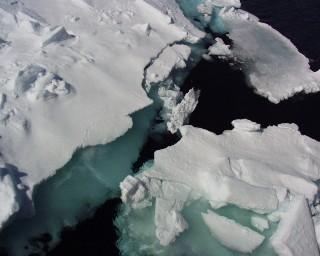
Views of ice from the helicopter
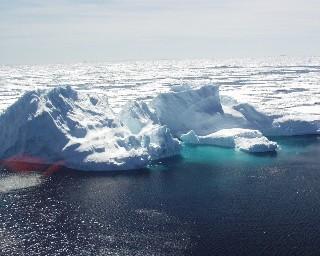
This is the iceberg we circled in the helicopter.
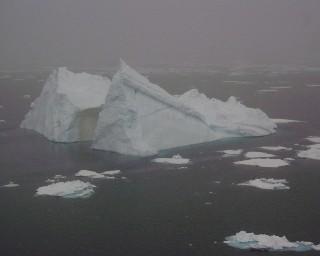
This is one of the icebergs that we saw from the helicopter.
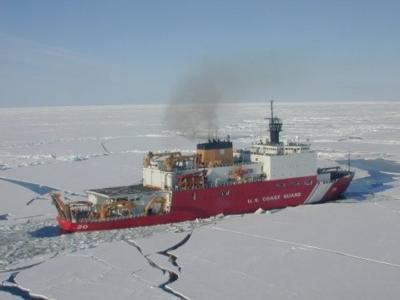
That's what the Healy looks like from the sky.

Off in search of just the right kind of ice!
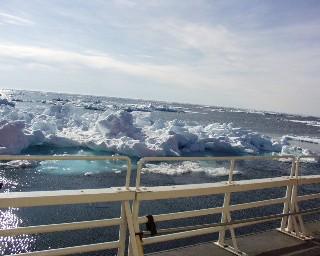
This is some ice off the starboard side.
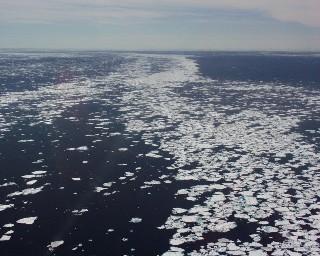
More ice!
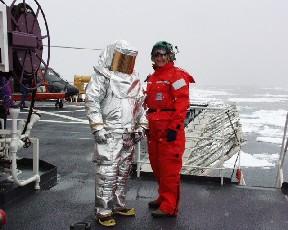
The "baked potato" man and I wait for the helicopter to be read for flight. He will not fly. He will watch for fires and smoke and make sure the plane is safe.
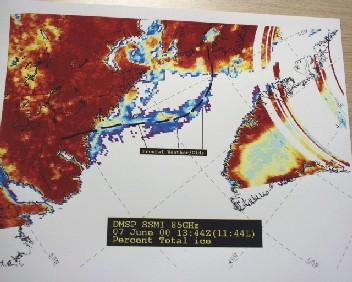
Bob Whritner interprets satellite images that show ice cover for this area today.
Contact the TEA in the field at
.
If you cannot connect through your browser, copy the
TEA's e-mail address in the "To:" line of
your favorite e-mail package.
|
